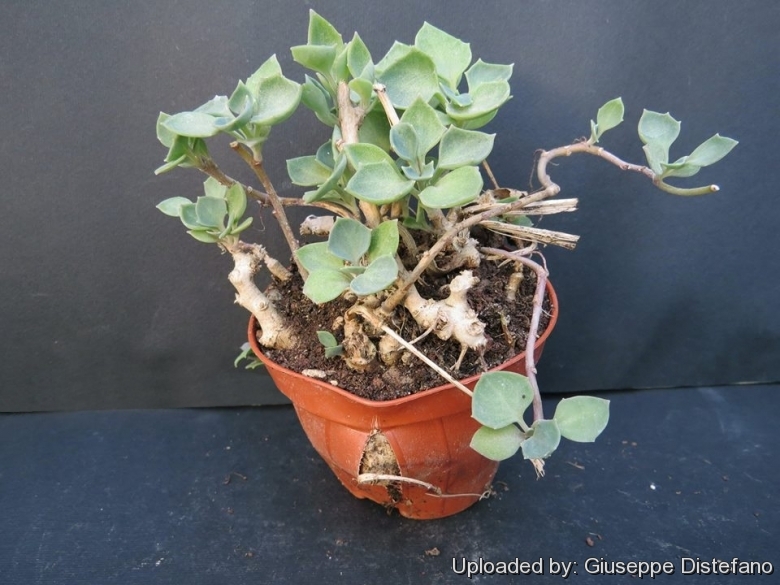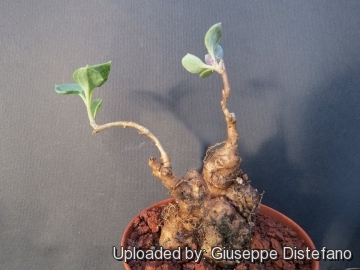Accepted Scientific Name: Senecio kleiniiformis Suess.
Repert. Spec. Nov. Regni Veg. 42: 45 45 1937

Kleinia kleiniiformis (Senecio kleiniiformis) Photo by: Giuseppe Distefano
(as: Senecio cuneatus) This succulent herb has nicely formed knobby roots. The tuberous roots can be raised above ground for bonsai effect. .
Origin and Habitat: It seems that this species is native to South Africa, but there are doubts about its real origin as some botanists mention that Senecio kleiniiformisSN|29618]]SN|29618]] has not yet been located in the wild. This species is thought to be found only in cultivation.
Synonyms:
See all synonyms of Senecio kleiniiformis
back
Accepted name in llifle Database:Senecio kleiniiformis Suess.Repert. Spec. Nov. Regni Veg. 42: 45 45 1937Synonymy: 9
back
Common Names include:
ENGLISH: Spear head, Texas groundsel, Spearhead senecio, Reindeer antlers
Description: Senecio kleiniiformisSN|29618]]SN|29618]], commonly called Spear head is a slow-growing succulent with light grey-green fleshy leaves, which are basically three(or five)-sided and look a bit like a spear or arrow tip. The species is variable; in some instances, leaves may be shorter and spoon shaped. It produces profuse pale yellow flowers that are not that attractive on the end of summer and early fall.
Taxonomy: This plant is of controversial origin, possibly a cultigen (i.e. a plant of commerce that has been selected by humans and used in horticulture), and does not have any naturally occurring populations though closely related Senecio occur in South Africa. Nomenclature is controversial too and is common in cultivation under a variety of misnomers, furthermore two taxa are probably confused here, both hybrids of Senecio articulatusSN|18917]]SN|18917]].
Habit: Senecio kleiniiformisSN|29618]]SN|29618]], is a pruinose, glabrous, prostrate evergreens succulent herb with nicely formed knobby roots. The tuberous roots can be raised above ground for bonsai effect.
Branches: Trailing or ascending and rooting, to 60 cm and 7-10 mm in diameter, with visible leaf-scars.
Leaves: Cylindrical at the base and ending in a triangular point, the leaves of this plant have a caracteristic shape reminiscent of a spearhead. They are soft, fleshy and rubbery (3-)6-10 cm long, 1.2-2.5 cm wide with a long tapering wedge-shaped petiole and spatulate or triangular pointed tip with 3 - 5 acute lobes, channelled and V-shaped in cross-section, keeled underneath, in some instances, leaves may be shorter and spoon shaped. Epidermis with a white powdery pruine giving the leaves a bluish-silver appearance (pale green beneath the pruine).
Inflorescence: Erect well above the foliage, up to 60 cm long, subcorymbose with 10-30 capitula.
Flowers (capitula): Tiny Pom-poms-like yellow or whitish. Phyllaries 8 (-10). Ray florets none. Disc florets 15-20, white.
Chromosome number: 2n = 20, 80.
Bibliography: Major references and further lectures
1) Wikipedia contributors. "Senecio kleiniiformis." Wikipedia, The Free Encyclopedia. Wikipedia, The Free Encyclopedia, 5 Mar. 2009. Web. 23 Nov. 2014.
2) Sir Joseph Dalton Hooker “The botany of the Antarctic voyage of H.M. discovery ships Erebus and Terror in the years 1839-1843: under the command of Captain Sir James Clark Ross, Kt.” Reeve, Brothers, 1844
3) Urs Eggli “Illustrated Handbook of Succulent Plants: Dicotyledons” Springer Science & Business Media, 2002
4) Debra Lee Baldwin “Succulents Simplified: Growing, Designing, and Crafting with 100 Easy-Care Varieties” Timber Press, 21/May/2013
 Kleinia kleiniiformis (Senecio kleiniiformis) Photo by: Giuseppe Distefano
Kleinia kleiniiformis (Senecio kleiniiformis) Photo by: Giuseppe DistefanoSend a photo of this plant.The gallery now contains thousands of pictures, however it is possible to do even more. We are, of course, seeking photos of species not yet shown in the gallery but not only that, we are also looking for better pictures than those already present.
Read More... Cultivation and Propagation: Very easy to grow, Spear Head (Senecio kleiniiformisSN|29618]]SN|29618]]) makes a great medium height ground cover with fine texture and makes a very ornamental pale blue colouring in full sun in warm climates and, is somewhat fire-retardant due to extreme succulence of leaves. It contrasts well with broader succulent foliage like Aloe barberaeSN|31628]]SN|26265]] and Aloe plicatilisSN|26265]]SN|31628]]. It is drought tolerant, but will accept irrigation. It makes an attractive patio or porch plant in warmer climates, and can be grown as a houseplant in cooler climates. The plant's airy appearance and trailing growth habit make it excellent for hanging baskets. Moreover, this succulent plant is capable of surviving a temperature of -5°C.
Soil: It requires a free draining enriched soil, mildly acidic to mildly alkaline but is very tolerant of poor soils. It can be planted in the ground – in a sandy soil or in clay – in containers, on rooftops and even on walls.
Repotting: Repot spear head whenever you see roots around the drainage holes of the pot. Replant the succulent in the evening and choose a pot with drainage holes. Use well-draining, sandy, cactus potting mix.
Fertilization: Fertilizing spear head encourages stronger, healthier growth. Fertilize the plant with a liquid 2-7-7 succulent fertilizer once a month from spring to late summer.
Watering: This plant seems to thrive with summer irrigation but does well if withheld and tolerates winter rainfall if soil drains tolerably well. It adapts to different growing conditions from extreme heat and drought, to high moisture as it has a low rot potential. One watering per month will be necessary during winter.
Exposition: They seem to do well in part shade such as at the base of trees, but thrives also in hot sunny positions and will tolerate coastal conditions. Place spear head on a lightly shaded patio, porch or balcony or near a window where it will receive direct morning sun or partly shaded afternoon sun.
Frost Tolerance: It is cultivated in open air in the tropical and warm Mediterranean climate, with temperatures which it is good to keep over the 5°C, best 10-12°C, but can withstand light frost for short periods if very dry (hardy down -5º C, even if with damage to the foliage) in these situations it will better resist if sheltered by the winter rains, seen that the humidity and low temperatures render it more sensitive to rottenness. Plants in containers however, suffered major leaf loss. Once the season is over, it is possible to bring the Spear Head in your house where it will easily tolerate the intense heat and drought. USDA Zone 9b to 12.
Wind and salt tolerance: Tolerates well high wind and second line salt wind.
Maintenance: The flower stems need to be removed to keep a tidy appearance. These species do tend to get sort of leggy, which is particularly a problem if grown as a potted plant, and yearly trimming back is often necessary. Cut back in late summer. Because old leaves fall off and new ones grow at the ends of the stems, it becomes lanky unless made to branch. The flowers are not very showy and may be cut off to preserve the beauty of the foliage. If the plant drops any of its leaves, remove them from the soil and discard them before they have a chance to rot or to grow mold, which can spread to the rest of the plant. This is particularly important during the winter, as the cold, wet weather encourages mold growth.
Propagation: It is easy to propagate by cuttings in late spring to summer, just take a cutting of the plant let it dry for 1 or 2 weeks and stuff it in the ground (preferably dry, loose, extremely well draining soil). Once established this pant provides a source of cuttings to give away or to fill gaps in the garden.











